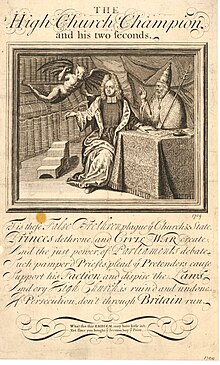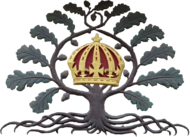High church
This article needs additional citations for verification. (August 2023) |
| Part of a series on |
| Anglicanism |
|---|
 |
|
|
The term high church refers to beliefs and practices of Christian
Variations
Because of its history, the term high church also refers to aspects of Anglicanism quite distinct from the Oxford Movement or Anglo-Catholicism. There remain parishes that are high church and yet adhere closely to the quintessentially Anglican usages and liturgical practices of the Book of Common Prayer.
High church Anglicanism tends to be closer than low church to
High church nonetheless includes many bishops, other clergy and adherents sympathetic to mainstream modern consensus across reformed Christianity that, according to official Roman Catholic and Eastern Orthodox Christian teachings, are
The term high church has also been applied to elements of Protestant churches within which individual congregations or ministers display a division in their liturgical practices, for example, high church
Evolution of the term

High church is a
Over time several of the leading lights of the Oxford Movement became Roman Catholics, following the path of
Before 1833
| Part of the Politics series on |
| Toryism |
|---|
 |
During the reign of King
During the reign of King Charles I, however, as divisions between Puritan and Catholic elements within the Church of England became more bitter, and Protestant Nonconformity outside the Church grew stronger in numbers and more vociferous, the High Church position became associated with the leadership of the High Church Archbishop of Canterbury, William Laud, (see Laudianism), and government policy to curtail the growth of Protestant Dissent in England and the other possessions of the Crown. See, for example, the attempt to reimpose episcopacy on the Church of Scotland, a policy that was 'successful' until the reign of William and Mary, when the office of bishop was discontinued except among the small minority of Scots who belonged to the Scottish Episcopal Church.
In the wake of the disestablishment of Anglicanism and the persecution of Anglican beliefs and practices under the
Later events surrounding the attempts of the Jacobites, the adherents of the excluded dynasts, to regain the English and Scottish thrones, led to a sharpening of anti-Catholic rhetoric in Britain and a distancing of the High Church party from the more ritualistic aspects of Caroline High churchmanship, which were often associated with the schismatic Non-Jurors. Thomas Hancorne, a Welsh clergyman prominent in jacobite circles, gave the County of Swansea's assize sermon on 18 April 1710 (The right way to honour and happiness), during which he complained of the "rapid growth of deist, freethinking and anti-trinitarian views."[3][4] The targets of Hancorne's wrath were "irreligion, profaneness and immorality", as well as the "curious, inquisitive sceptics" and the "sin-sick tottering nation". Later, he engaged in a campaign to reassert tithe rights.[5] Eventually, under Queen Anne, the High Church party saw its fortunes revive with those of the Tory party, with which it was then strongly associated.
However, under the early Hanoverians, both the High Church and Tory parties were once again out of favour. This led to an increasing marginalisation of High Church and Tory viewpoints, as much of the 18th century was given over to the rule of the Whig party and the aristocratic families who were in large measure pragmatic latitudinarians in churchmanship. This was also the Age of Reason, which marked a period of great spiritual somnolence and stultification in the Church of England.
Thus, by the end of the 18th century and the beginning of the 19th, those liturgical practices prevalent even in High Church circles were not of the same tenor as those later found under the Catholic revival of the 19th century. High Church clergy and laity were often termed high and dry, in reference to their traditional high attitude with regard to political position of the Church in England, and dry faith, which was accompanied by an austere but decorous mode of worship, as reflective of their idea of an orderly and dignified churchmanship against the rantings of the low churchmen that their Cavalier ancestors had defeated. Over time, their High Church position had become ossified among a remnant of bookish churchmen and country squires. An example of an early 19th-century churchman of this tradition is Sir Robert Inglis MP.
From 1833

Only with the success of the Oxford Movement and its increasing emphases on
From the mid-19th century onward, the term High Church generally became associated with a more avowedly Anglo-Catholic liturgical or even triumphalist position within the English Church, while the remaining Latitudinarians were referred to as being Broad Church and the re-emergent evangelical party was dubbed Low Church. However, high church can still refer to Anglicans who hold a high view of the sacraments, church tradition and the threefold ministry but do not specifically consider themselves Anglo-Catholics.
Anglican Communion
Notable parishes
Notable institutions
See also
- Affirming Catholicism
- Anglican devotions
- Anglo-Catholicism
- Broad church
- Central churchmanship
- Crypto-papism
- Christian monasticism
- Church of England
- Church of South India
- Churchmanship
- Continuing Anglican Movement
- Evangelical Catholic
- High Church Lutheranism
- High Mass
- Neo-Lutheranism
- Ritualism
- Society of Catholic Priests
- Scottish Church Society
Bibliography
- Addleshaw, G. W. O. (1941) The High Church Tradition: a study in the liturgical thought of the seventeenth century. London: Faber
- Cross, F. L. (ed.) (1957) The Oxford Dictionary of the Christian Church. London: Oxford U. P.; High Churchmen, p. 636
- Hein, David (1991) "The High Church Origins of the American Boarding School" in: Journal of Ecclesiastical History 42 (1991): 577–95.
- Hylson-Smith, Kenneth (1993) High Churchmanship in the Church of England, from the sixteenth century to the late twentieth century. Edinburgh: T & T Clark
References
- OUP
- ^ "High Churchman". Oxford English Dictionary (Online ed.). Oxford University Press. (Subscription or participating institution membership required.)
- ^ Jenkins, Philip (March 1985). "Tory Industrialism and Town Politics: Swansea in the Eighteenth Century". The Historical Journal. 28 (1): 103–123. Retrieved 21 May 2023.
- ISBN 1385401079.
- ^ Jenkins, Philip (1984). "Church Patronage and Clerical Politics in Eighteenth-Century Glamorgan". Morgannwg. 28: 46–48. Retrieved 11 August 2023.
External links
- High Church vs. Low Church: Documentary Narrative of an Ecclesiastical Joke compiled by Richard Mammana and Cynthia McFarland for Anglicans Online
